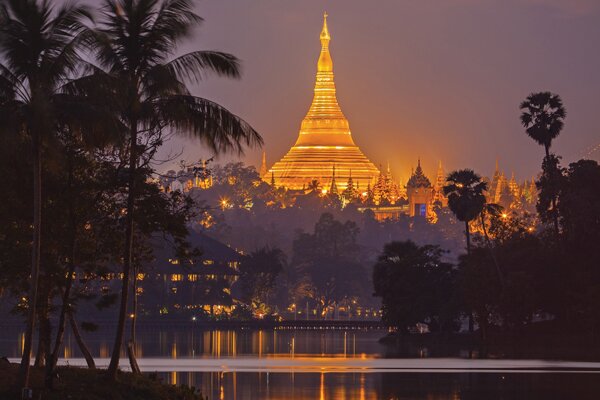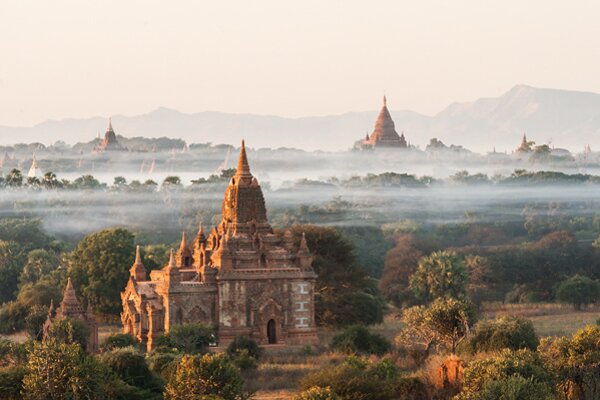Abu Dhabi Week takes a trip into Southeast Asia’s Golden Country
At dawn in front of the Shwedagon Pagoda in Rangoon, men and women wearing matching blue T-shirts with tracksuit bottoms gather. They are here to perform their daily exercise ritual as the sun rises over the gleaming golden edifice before them. Although it’s only 5.30am they are not alone, there are scores of Rangoon residents taking advantage of the (relative) coolness and out jogging alongside the prettily manicured banks of Kandawgyi Lake. Among them, though, tourists start to appear, making their way to the famous pagoda.
After some 50 years of oppressive rule Burma, or Myanmar as the military government renamed it in place of the moniker given under British rule, is changing. Following the release of democratic leader Aung San Suu Kyi from house arrest and her party’s approval of foreign visitors, the country is opening up to tourism.
A sign outside Yangon (similarly renamed from Rangoon) airport reads: Welcome to Myanmar – the Golden Country. It’s an appropriate enough description for a place that’s teaming with gold leaf and gold-painted pagodas and whose inhabitants are optimistic and friendly – curious to talk to visitors after decades of tourism boycotting by the world at large.
Rangoon, the former capital, is the starting point for most visits to Burma and during a 48-hour stopover you can see the highlights of the city’s attractions. Start with a dawn visit to the Shwedagon Pagoda before the heat and crowds get too much. People watching is as fascinating as the towering, gold-leafed, diamond studded stupa itself. Burmese are deeply religious and a visit to a temple – often to pile yet more gold leaf on to pagodas and Buddha statues – is part of daily life.
Shwedagan has particular resonance as it’s deemed the country’s holiest shrine. Dotted around the pagoda are monuments representing each day of the week. Devotees offer flowers and miniature parasols according to the day of the week they were born on and which day the fortune-tellers have advised them on. Many spend the whole day here, bringing their children and eating together there.
Similarly at the Chauk Htat Gyi. In front of the mammoth Reclining Buddha (one of the biggest in South East Asia) groups of women sit and chat on the floor with a spread of tiffin boxes before them, tucking into a mid-morning meal. Their faces are smeared with Thanaka, a cream-coloured sun block made from tree bark.
A short drive away via China Town, Scotts Market is handily undercover to escape the midday heat. Inside locals shop for fabrics and food (and visitors for jade, gems and gold). On the outskirts you can’t move for Aung San Suu Kyi paraphernalia. Her likeness is emblazoned on T-shirts and mugs and bootleg DVDs of The Lady.
Next door, the former railway headquarters is being renovated but the grandeur has well and truly faded on most of the Victorian colonial buildings built under British rule in the city. They stand crumbling helplessly, their future uncertain. The Strand hotel is one gem still intact. Built by the Sarkies brothers who also built the iconic Raffles hotel in Singapore, it’s a white-columned beauty well worth a look.
Where to stay
The Governors Residence in the embassy quarter is a gorgeous 1920s teak mansion. The airy verandahs and inviting green swimming pool provide respite in the heat of the day before and after early morning and late afternoon sightseeing forays. www.governorsresidence.com
Top Tips
- There are currently no ATMs in Myanmar and credit cards are only accepted in some five star establishments. Take plenty of pristine US dollars (tattered ones will be rejected) with you to use or change into kyats – the local currency.
- If you’re wearing shorts or skirts they must cover your knees in order to visit a temple or pagoda.
- Taxis in Yangon don’t have meters so always agree a price before getting in. Hotels and restaurants will be able to advise/negotiate for you.
Eating
Burmese food has influences from the countries that surround it: Thailand, China and India. The bounty of produce grown in the country is reflected in the dishes offered: fried butter beans, banana blossom and tea leaf salads and mutton and chicken curries.
These are shared family style and accoutrements including chillies, ginger, lime and roasted peanuts are added for personal taste.
Feel Myanmar in Dagon Township (Tel: 725 736) offers traditional Burmese salads and curries in a casual setting. Point to the dishes you want.
Mandalay at The Governors Residence hotel cleverly combines Burmese ingredients and flavours with modern European presentation. www.governorsresidence.com/web/pyan/mandalay_restaurant.jsp
























